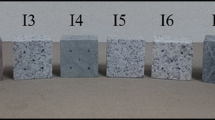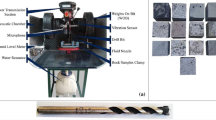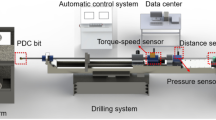Abstract
The drilling operation is one of the significant phases in geosciences. Analyzing this function assists investigators to determine the correct standpoint on the drilling process itself. The drilling operation generates acoustic frequencies as a beneficial derivative output, which could facilitate achieving this standpoint. On the other hand, determining the properties of rocks plays a critical role in all downstream stages of the operation. Determining rock characteristics using direct geomechanical methods is time-consuming and expensive, and requires excessive accuracy. The dvelopment a frequency-based technique for predicting the geomechanical functions of rocks would solve these problems. Here, we discuss the logical relations between rock characterization and the first five dominant acoustic frequencies of the drilling operation, as determined by first recording and then analyzing the frequencies of the acoustic signals generated during the drilling operation, using Fast Fourier Transform. For providing a comparable condition, we developed a novel rotary drilling device. Eight carbonate rock samples were collected that covered a wide range of geomechanical features and used in the geomechanical and drilling tests. The results show there are reliable mathematical relations between various characteristics of carbonate rock samples (uniaxial compressive strength, tensile strength, S-wave and P-wave velocity, hardness) and diverse dominant frequencies of the drilling acoustic signals.









Similar content being viewed by others
References
Briševac Z, Kujundžić T (2016) Models to estimate Brazilian indirect tensile strength of limestone in saturated state. Rudarsko-geološko-naftni zbornik 31:59–67
Flegner P, Kačur J, Durdán M, Leššo I, Laciak M (2014) Measurement and processing of vibro-acoustic signal from the process of rock disintegration by rotary drilling. Measurement 56:178–193
Gradl C, Eustes AW, Thonhauser G (2008) An analysis of noise characteristics of drill bits. In: ASME 2008 27th International Conference on Offshore Mechanics and Arctic Engineering, 2008. American Society of Mechanical Engineers, pp 681–687
Gradl C, Eustes AW, Thonhauser G (2012) An analysis of noise characteristics of drill bits. J Energ Resour Technol 134:013103
Hardy HR (1972) Application of acoustic emission techniques to rock mechanics research. In: Acoustic emission. ASTM International, West Conshohocken
Hatherly P (2002) Rock strength assessment from geophysical logging. In: Proc 8th Int Sympon Borehole Geophysics for Minerals, Geotechnical and Groundwater Applications. Toronto, ON, Canada
Kivade SB, Murthy CSN, Vardhan H (2015) ANN models for prediction of sound and penetration rate in percussive drilling. J Inst Eng (India) Ser D 96:93–103
Kostur K, Futo J (2007) Optimization of rock disintegration based on acoustic background of drilling machine. Mech/AGH Univ Sci Technol 26:1–7
Kumar BR, Vardhan H, Govindaraj M (2010) Estimating rock properties using sound level during drilling: field investigation. Int J Min Mineral Eng 2:169–184
Kumar BR, Vardhan H, Govindaraj M (2011a) Prediction of uniaxial compressive strength, tensile strength and porosity of sedimentary rocks using sound level produced during rotary drilling. Rock Mech Rock Eng 44:613–620
Kumar BR, Vardhan H, Govindaraj M (2011b) Sound level produced during rock drilling vis-à-vis rock properties. Eng Geol 123:333–337
McNally G (1990) The prediction of geotechnical rock properties from sonic and neutron logs. Explor Geophys 21:65–71
Miklusova V, Usalova L, Ivanicova L, Krepelka F (2006) Acoustic signal–new feature in monitoring of rock disintegration process. Contrib Geophys Geodesy 36:125–133
Obert L (1941) Use of subaudible noises for prediction of rock bursts. U.S Bureau of Mines R.I. 3555. U.S. Bureau of Mines, Washington D.C.
Obert L, Duvall W (1942) Use of subaudible noises for the prediction of rock bursts, part II. US Bur Mines Rep 4:365
Roy S, Adhikari G (2007) Worker noise exposures from diesel and electric surface coal mining machinery. Noise Control Eng J 55:434–437
Shreedharan S, Hegde C, Sharma S, Vardhan H (2014) Acoustic fingerprinting for rock identification during drilling. Int J Min Miner Eng 5:89–105
Vardhan H, Bayar RK (2013) Rock engineering design: properties and applications of sound level. CRC Press, Boca Raton
Vardhan H, Murthy CS (2007) An experimental investigation of jack hammer drill noise with special emphasis on drilling in rocks of different compressive strengths. Noise Control Eng J 55:282–293
Vardhan H, Adhikari G, Raj MG (2009) Estimating rock properties using sound levels produced during drilling. Int J Rock Mech Min Sci 46:604–612
Ward B (1998) German Creek Mines Rock strength from velocity logs Unpublished report. Capricorn Coal Management Pty Ltd., South Brisbane, Australia
Williams E, Hagan P (2006) Monitoring acoustic emission levels with changes in rock cutting conditions. University of New South Wales, Sydney. www.mining.unsw.edu.au/Publications/publications_staff/Paper_WilliamsHogan_AE_2006_web.htm
Zang A, Wagner CF, Dresen G (1996) Acoustic emission, microstructure, and damage model of dry and wet sandstone stressed to failure. J Geophys Res Solid Earth 101:17507–17521
Zborovjan M (2001) Identification of minerals during drilling process via acoustic signal. Metall Foundry 26:367–374
Zborovjan M, Lesso I, Dorcak L (2003) Acoustic identification of rocks during drilling process. J Acta Montanist Slovaca 8:91–93
Author information
Authors and Affiliations
Corresponding author
Rights and permissions
About this article
Cite this article
Yari, M., Bagherpour, R. & Khoshouei, M. Developing a novel model for predicting geomechanical features of carbonate rocks based on acoustic frequency processing during drilling. Bull Eng Geol Environ 78, 1747–1759 (2019). https://doi.org/10.1007/s10064-017-1197-y
Received:
Accepted:
Published:
Issue Date:
DOI: https://doi.org/10.1007/s10064-017-1197-y




